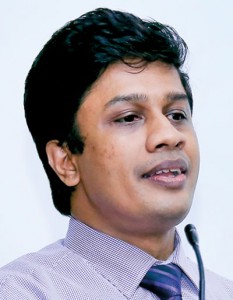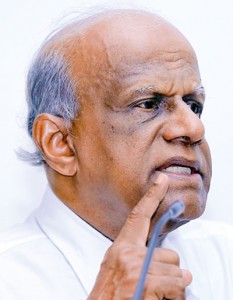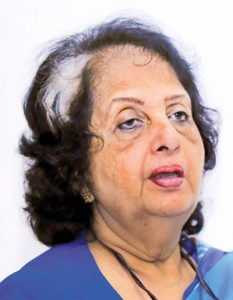News
It’s not only numbers that matter

Medical students in an attala (hut) at the Colombo Medical Faculty. Pix by Anurada Bandara
The presentations were illuminating, while robust was the discussion that followed when the all-important question of ‘How many doctors does Sri Lanka need’ was taken up by the College of Medical Educationists Sri Lanka.
‘Whatever is done at this moment should be done very cautiously with proper planning. If we want to improve the system it should be done with a proper situational analysis. If not, the system can get crippled and it will be too late to make adjustments later,’ was the take-home message which came out strongly after more than three hours of discussion on the afternoon of April 4 at the Main Hall of the Faculty of Medicine, University of Colombo.
Making it crystal clear, why the College of Medical Educationists, as academics and scholars, has got involved, its President Prof. Indika Karunathilake said that Sri Lanka’s health system is one of the best, which the world has accepted. “We are maintaining it with < 2% of GDP allocation from the government, while in the United States of America it is 18%. The production of doctors is one of the ‘main important inputs’ to this system and it can alter the system dynamics.”
He said that the discussions on how many doctors Sri Lanka needs have to be based on the health requirements of the country and also facts, figures and principles and not on biases.
Lamenting that Sri Lanka has “still not decided how to decide”, former President of the Sri Lanka Medical Council (SLMC) and Past President of the Sri Lanka Medical Association (SLMA), Prof. Lalitha Mendis said that as far back as a decade ago (2006), she had made a presentation on this important issue and the need to balance the demand and supply of doctors in Sri Lanka. “We are still asking that question.”

Prof. Indika Karunathilake
This much-respected academic said that medicine has so many categories that we cannot simply say we want this many Outpatient Department doctors. We need to go into each category, while planning meticulously, taking into account doctors both in the government and private sectors.
“We have never had good and effective planning. We pay lip service but don’t practise it,” said Prof. Mendis, recalling how way back in 1981, the focus of the World Health Assembly was primary healthcare. “What have we done? Have we considered General Practitioners (GPs) as an offshoot of primary healthcare? Should there be government-paid GPs? When we count doctors, what of ayurvedic practitioners who fulfil some sort of service?”
A universal truth is that there will be no health without a workforce, pointed out a former World Health Organization (WHO) consultant and Past President of the SLMA, Dr. Palitha Abeykoon, questioning what an “ideal” physician-to-population ratio would be.
“Hospitals, other medical facilities and physicians ask about ideal physician-to-population ratios. Are there ratios to show how many doctors in various specialties are needed to serve a given population,” he asked, stating that several answers are being given…. But in reality it should be ‘No’. Caution should be exercised when considering these ratios because when it comes to medical services, one size does not fit all. A comprehensive plan, according to the WHO, should include not just physician-to-population ratios but a complete analysis of the existing medical staff and the needed services.
Referring to the key implications for decision-makers, Dr. Abeykoon said that health human resources planning should be needs-based and outcomes-directed. It should not assume that healthcare needs in the population remain constant, even to focus on short 5 to10-year planning horizons. The changes in the population’s health needs over time are complex and will vary by sex, age group, education and place of residence. The changes in technology can make a significant difference in both demand and supply.
He detailed some criteria relating to health workforce planning as: Population and population growth; economic growth; demography and epidemiology; proportion of the government budget allocated to health and to personnel emoluments; private expenditure on health care; and non-government provision of health services.
The WHO’s concerns on the health workforce, according to Dr. Abeykoon are:
Availability — the sufficient supply and stock of health workers, with the relevant competencies and skill mix among different categories of health workers that correspond to the health needs of the population;
Accessibility — the equitable access to health workers, including travel time and transport, disability-friendly, referral mechanisms and cost of services;

Dr. Palitha Abeykoon
Acceptability — treat everyone with dignity, create trust and enable or promote demand for services;
Quality — the competencies, skills, knowledge and behaviour of the health worker according to professional norms and as perceived by users.
Taking the case of India, Dr. Abeykoon was quick to point out that it planned to establish some 200 new medical colleges in the next 10 years to meet the projected huge shortage of 600,000 doctors. The basis for arriving at this huge projected shortage is the recommendation about the minimum doctor:population ratio of 1:1000 by the ‘High Level Expert Group (HLEG)’ constituted by the country’s Planning Commission.
However, he was of the view that the Indian government should desist from implementing its decision to create a huge number of medical colleges. Just as no battle has been won in human history by ill-trained armies, the woes of the health sector cannot be solved by ill-trained doctors.
As such, Dr. Abeykoon concluded that few would deny that health care issues incite controversy, for example SAITM (South Asian Institute of Technology and Medicine) generating much debate. But numerous other issues, including questions about how we should recruit, educate, utilize and pay our doctors (and the health-care workforce), can also be controversial.
“There frequently is much disagreement when my colleagues discuss such matters among themselves. In fact, the disagreement has reached such a level that often I no longer agree with myself,” he said, drawing much laughter, while also asking how many doctors are needed for good health care.
“It is not merely a question of numbers. There is no ‘magic bullet’ solution ….and this discussion is likely to continue for a while,” he added.
The discussion also centred around the fact that it is not only doctor numbers which should be right but also other important health personnel such as nurses, physiotherapists etc.
A doctor from the National Cancer Institute at Maharagama pointed out how all teams – Consultants, Junior Doctors and Nurses — were ready to perform several surgeries on a particular day, but were able to do only one operation. Why? There were no attendants to wheel the patients in and out of the operating theatre.

Prof. Lalitha Mendis
| No interns if state students don’t attend lectures If students in the eight state medical faculties do not go back to their lecture halls, there will be no intern-doctors to serve in all hospitals spread across the country next year, is a very disturbing fact that came up during the discussion. All students of the Colombo, Peradeniya, Jaffna, Ragama, Sri Jayewardenepura, Ruhuna, Raja Rata and Eastern Medical Faculties have been in attala (huts) for more than a year (420 days) and not attending lectures for three months, protesting against untrained medical graduates being put out by the South Asian Institute of Technology and Medicine (SAITM). With the President of the College of Medical Educationists, Prof. Indika Karunathilake stressing that medical education should be based on health needs, quality and standards, merit and equity, a question which came up from the audience was whether the state medical faculties had standards or not as alleged by some senior doctors themselves. “The state medical faculties have very good standards,” stressed Prof. Lalitha Mendis, laughingly adding that they take the “juice” out of the medical students, as they have to go through both rigorous training and testing. “Yes, there are young faculties such as Raja Rata and Eastern, but if half the money given to SAITM is given to them, they can vastly improve their facilities.” A doctor-member of the audience who is working in Australia was also quick to point out that Sri Lankan doctors were able to get jobs there, as standards are good.
|

